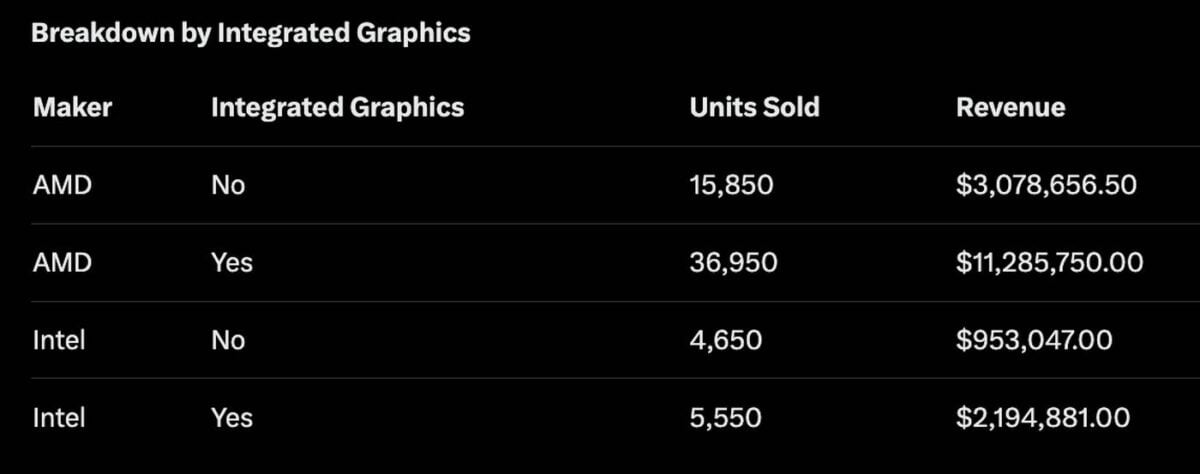AMD continues its dominance when it comes to CPU sales for custom PC builds, apparently beating Intel five to one when it comes to sales on Amazon. According to Amazon US October retail sales data, shared by @TechEpiphanyYT on X, Ryzen CPUs account for approximately 84% of sales, with over 52,800 units sold, compared to 10,200 for Intel. Significantly, more 9800X3D and 7800X3D chips are being sold than the entirety of Intel’s current desktop product range.
According to this data, AMD sold 36,950 Ryzen chips with integrated graphics, like the Ryzen 9 9950X and 9900X, representing revenue of about $11.2 million. alongside 15,850 chips without GPUs models, worth around $3 million. Intel on the other hand, sold 5,550 iGPU-equipped CPUs, worth around $2.1 million, plus 4,650 F-branded variants without GPUs, worth $0.9 million. In other words, AMD’s share represents more than 80% whether you look at unit sales or revenue.
More shocking are the huge sales of AMD’s Ryzen 7800X3D and 9800X3D, two chips that together account for more sales than Intel’s entire desktop portfolio. These CPUs aren’t cheap either, indicating that, if performance is worth the price, many are willing to pay for it. At the same time, Intel’s Core Ultra 200 CPUs have failed to provide noticeable performance gains over their predecessors, sometimes even failing to meet their sales.
However, this doesn’t mean there is no place for affordable options. The six-core Ryzen 5 9600X and Ryzen 5 5500 each managed to convince some 5,000 customers to buy them. At $75, the latter offers a cheap entry to the AM4 platform for those on a limited budget, with the possibility to upgrade to more powerful chips down the line. That said, Intel saw some success with the mid-range Core Ultra 7 265K, which managed to win over 1,000 customers following its price drop to $300.
Overall, the average selling price of AMD CPUs was $272.05, against $308.62 for Intel. This suggests that Ryzen cuyers prefer the value offered by the mid-range and low-end range, while Intel customers prefer high-end options, perhaps due to their high core counts and multi-threading performance.

I still remember when the situation was the other way round, when AMD was struggling to compete, leaving Intel to dominate the market. AMD’s Bulldozer chips drew lots of power and ran hot, compared to Intel’s efficient and powerful CPUs. Just like today, where we recommend gamers to buy mid-range Ryzen CPUs, especially the X3D variants, back then most users went with a Core i5 since the i7 range only added Hyper-Threading. How the tables have turned.
If we can learn anything from history it’s that nothing is set in stone, and Intel could come back raging with some new technology to dethrone AMD. However, it can’t afford to let its guard down, and will need to do more than targeting incremental performance uplifts.
According to rumours, AMD’s upcoming Zen 6 architecture may offer more cores per CCD compared to Zen 5, while there are reports of a 52-core Intel Nova Lake CPU on the way. It looks as though exciting times are coming in the CPU market, but Intel doesn’t have time to rest.
To stay up to date regarding this and many other things, don’t forget to follow the Club386 Google News.

